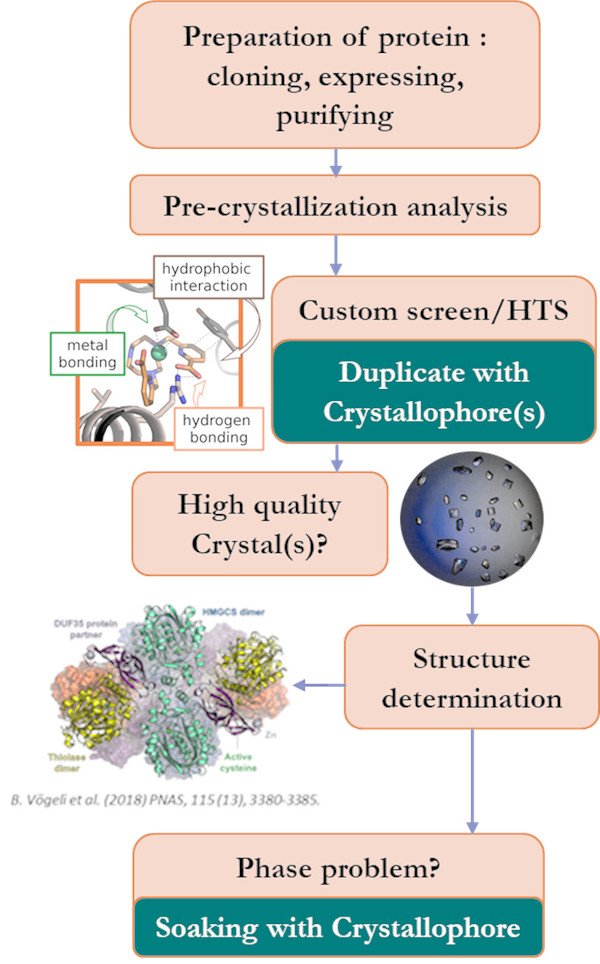Polyvalan Crystallophore Pre-Screening and Experimental Phasing Agents-MiTeGen预筛选和实验定相剂
上海金畔生物代理MiTeGen品牌蛋白结晶试剂耗材工具等,我们将竭诚为您服务,欢迎访问MiTeGen官网或者咨询我们获取更多相关MiTeGen品牌产品信息。
Polyvalan Crystallophore Pre-Screening and Experimental Phasing Agents
Polyvalan new generation Crystallophores are Lanthanide based complexes that will help you to get more structures.
Polyvalan Crystallophore 预筛选和实验定相剂
Polyvalan 新一代 Crystallophores 是基于镧系元素的复合物,可帮助您获得更多结构。
1) WHEN USED AS PRE-SCREENING AGENTS
Crystallophores unique nucleating properties are related to versatile protein binding sites and supramolecular interactions.
TbXo4-02-N and LuXo4-01-N are two different generations of Lanthanide complexes (Terbium or Lutetium) presenting complementary nucleation enhancement mainly adapted to soluble proteins and complexes.
As pre-screening agents, Crystallophores shall be directly dissolved first with the protein solution at a concentration of 10 mM before running crystallization screening. Every vial is adapted to 25 µL of protein solution.
They can be useful for:
- Generating new crystallization conditions
- Inducing different crystal forms
- Improving crystal quality and reproducibility
Moreover, Crystallophores are designed to improve phasing properties of obtained co-crystals using SAD or MAD methods
- Llll absorption edge of LuXo4-01, at 1.34 Å, is easily accessed with most synchrotron-radiation sources leading to an anomalous contribution of about 30 e-
- TbXo4-02 is a straightforward PHASING AGENT thanks to the exceptional anomalous properties of f-block elements
- Both also works well with X-ray home source
2) WHEN USED AS PHASING AGENTS
TbXo4-02-P and LuXo4-01-P are powerful phasing agents for native crystals using SAD or MAD methods.
The soft incorporation of Crystallophore lanthanide atoms in macromolecular crystals allows to exploit information from anomalous diffraction data, including, when unoptimized or partial, for the validation of MR solutions and reduction of model/phase bias.
Soak your crystals with Crystallophore P vials (higher concentration required when compared to nucleation) during the cryoprotection step.
Important Notice – 30 seconds to 5 minutes are enough No back soak, it’s ready to use !
1) 当用作预筛选剂时
Crystallophores 独特的成核特性与多功能蛋白质结合位点和超分子相互作用有关。
TbXo4-02-N 和 LuXo4-01-N 是两代不同的镧系元素配合物(铽或镥),呈现出主要适用于可溶性蛋白质和配合物的互补成核增强。
作为预筛选剂,Crystallophores 在进行结晶筛选之前应先用 10 mM 浓度的蛋白质溶液直接溶解。每个小瓶都适用于 25 µL 的蛋白质溶液。
它们可用于:
产生新的结晶条件
诱导不同的晶型
提高晶体质量和重现性
此外,Crystallophores 旨在改善使用 SAD 或 MAD 方法获得的共晶的定相性能
LuXo4-01 的 Llll 吸收边为 1.34 Å,可通过大多数同步加速器辐射源轻松访问,导致异常贡献约为 30 e-
由于 f-block 元素的异常特性,TbXo4-02 是一种直接的 PHASING AGENT
两者也适用于家庭 X 射线源
2) 当用作调相剂时
TbXo4-02-P 和 LuXo4-01-P 是使用 SAD 或 MAD 方法的天然晶体的强大定相剂。
Crystallophore 镧系元素在大分子晶体中的软结合允许利用来自异常衍射数据的信息,包括在未优化或部分时,用于验证 MR 解决方案和减少模型/相位偏差。
在冷冻保护步骤中,用 Crystallophore P 小瓶(与成核相比需要更高的浓度)浸泡晶体。
重要提示 – 30 秒到 5 分钟就足够了 无需回浸,即可使用!
View our recorded meeting concerning Polyvalan’s Crystallophore Pre-Screening and Experimental Agents
Product Information
- More Product Information
- TbXo4-02 Technotes
- LuXo4-01 Technotes
- FAQ’s
- MSDS – User Guides
Each Polyvalan Crystallophore products can be used both as pre-screening agents and phasing agents.
The difference is how they are used depends on how they are packaged.
When used as pre-screening agents (for getting protein crystals), the aim is to enable users to limit their costly protein consumption. This is why the pre-screening agents are provided in small packaging adapted to 25 µL protein solution. The quantities of products are different (0,15mg and 0,17mg) because of their respective molar mass. We consider LuXo4-01 and TbXo4-02 as complementary nucleating agents. These agents are offered in batches of 5.
When used as phasing agents (for soaking protein crystals), a high concentration of the Crystallophore is required (100mM : 10 times more than for nucleation) : according to their respective molar mass, the packaging allow users to prepare 10 µl of soaking liquor (≈ 10 trials). The phasing properties are due to the Lanthanide atom “trapped” in the agents: Tb=Terbium and Lu=Lutetium. Each one has its own characteristics: the user can go to the one that seems the most suitable to their needs.
Second generation Terbium based Crystallophore, TbXo4-02 presents improved nucleation enhancement properties to Tb-Xo4 first generation.
When used as pre-screening agent, TbXo4-02 acts as a strong Nucleating Agent providing new crystallization conditions and generally leading to the formation of bigger TbXo4-02 derivatized co-crystals, ready-to-use for X-ray diffraction. TbXo4-02-N shall always be dissolved first with 25 µL of protein solution before running crystallization trials.
When used as experimental phasing agent, TbXo4-02-P is also a straightforward Phasing Agent facilitating crystal structure determination using SAD or MAD methods, due to the exceptional anomalous properties of f-block elements.
Lutetium based Crystallophore LuXo4-01-N does not only provide new crystallization conditions but it also improves the quality of the obtained crystals.
When used as pre-screening agent, LuXo4-01-N presents complementary nucleation enhancement to TbXo4-02. Both are mainly adapted to soluble proteins and complexes. LuXo4-01-N shall always be dissolved first with 25 µL of protein solution before running crystallization trials.
When used as experimental phasing agent, LuXo4-01-P overcomes the tedious and time-consuming work of seleno-methionine labeling or of heavy atom incorporation. LuXo4-01-P is fully compatible with conventional phasing methods. LIII absorption edge of Lu-Xo4, at 1.34 Å, is easily accessed with most synchrotron-radiation sources leading to an anomalous contribution of about 30 e-. This contribution is also important (10 e-) on a fixed-wavelength (1 Å) beam line allowing non-optimized SAD phasing
WHAT IS THE USUAL FINAL CONCENTRATION OF CRYSTALLOPHORES IN THE PROTEIN SOLUTION?
Xo4 should be dissolved by mixing it with protein solution to reach a final concentration of 10 mM. Then the crystallization experiments should be set up by mixing a volume of this « protein + Xo4 solution » with an equal volume of precipitant solution.
WHAT IS THE RANGE OF FINAL CONCENTRATIONS OF XO4 IN THE SAMPLE?
The proposed 10 mg/ml concentration is the optimal one. When hit is obtained, it’s possible to conduct an optimization by playing with the protein solution volume used in order to vary the Xo4 concentration from 1 to 10 mM.
ARE THERE ANY PROBLEMS USING ADDITIVES SUCH AS PHOSPHATE, EDTA OR EGTA?
There should be some competition with EDTA or EGTA to chelate the Lanthanide but we don’t know what will be the cinetic for a potential Lanthanide decorporation that could affect Xo4 efficiency. If EDTA or EGTA concentration is low (< 2 mM), this could only affect up to 20% of Xo4: the unaffected 80% are then still falling inside its efficiency range.
IS THERE ANY LIMITATION ON PH OR BUFFER COMPOSITION OR POSSIBLE LIGANDS IN CO CRYSTALLIZATION?
Xo4 has been designed in order to be stable and highly soluble in aqueous medium and consequently fully compatible with high throughput screening. It is stable in all crystallization conditions that have been tested; please note that in some cases the presence of phosphate can be detrimental to the efficiency of Xo4. When mixing the protein with Xo4, the solution may turn milky without affecting the subsequent screening. Check it for nano/micro crystals
WHAT ARE THE PREFERRED BINDING SITES OR AMINO ACIDS FOR TB-XO4?
There is direct interaction between protein negatively charged residues but not only.
ARE SOME GROUPS OF ENZYMES INHIBITED BY XO4?
It has never been observed but we cannot exclude it for very specific proteins.
Documentation
- MSDS LuXo4-01
- MSDS TbXo4-02
- User Guide – Polyvalan LuXo4-01
- User Guide – Polyvalan TbXo4-02
- Product Flyer
SKU: CPagents-CNagents 类别: 结晶筛,新产品
产品信息
更多产品信息
TbXo4-02 技术说明
LuXo4-01 技术说明
常见问题
MSDS – 用户指南
每种 Polyvalan Crystallophore 产品均可用作预筛选剂和定相剂。
不同之处在于它们的使用方式取决于它们的包装方式。
当用作预筛选剂(用于获取蛋白质晶体)时,目的是使用户能够限制其昂贵的蛋白质消耗。这就是预筛选试剂采用适合 25 µL 蛋白质溶液的小包装提供的原因。由于其各自的摩尔质量,产品的数量不同(0.15mg 和 0.17mg)。我们认为 LuXo4-01 和 TbXo4-02 是互补的成核剂。这些试剂以 5 个为一组提供。
当用作定相剂(用于浸泡蛋白质晶体)时,需要高浓度的 Crystallophore(100mM:比成核高 10 倍):根据它们各自的摩尔质量,包装允许用户制备 10 µl 浸泡液( ≈ 10 次试验)。定相特性是由于镧系元素被“捕获”在试剂中:Tb=铽和 Lu=Lutetium。每个都有自己的特点:用户可以选择最适合他们需求的那个。
第二代铽基晶体载体,TbXo4-02 与第一代 Tb-Xo4 相比,具有改进的成核增强特性。
当用作预筛选剂时,TbXo4-02 充当强成核剂,提供新的结晶条件并通常导致形成更大的 TbXo4-02 衍生化共晶,随时可用于 X 射线衍射。在进行结晶试验之前,TbXo4-02-N 应始终先用 25 µL 蛋白质溶液溶解。
当用作实验定相剂时,由于 f 区元素的异常异常性质,TbXo4-02-P 也是一种直接的定相剂,有助于使用 SAD 或 MAD 方法确定晶体结构。
镥基晶体载体 LuXo4-01-N 不仅提供了新的结晶条件,而且还提高了所得晶体的质量。
当用作预筛选剂时,LuXo4-01-N 呈现出与 TbXo4-02 的互补成核增强。两者都主要适用于可溶性蛋白质和复合物。在进行结晶试验之前,LuXo4-01-N 应始终先用 25 µL 蛋白质溶液溶解。
当用作实验定相剂时,LuXo4-01-P 克服了硒-蛋氨酸标记或重原子掺入的繁琐和耗时的工作。 LuXo4-01-P 与传统的定相方法完全兼容。 Lu-Xo4 的 LIII 吸收边为 1.34 Å,可通过大多数同步辐射源轻松访问,导致异常贡献约为 30 e-。这种贡献在固定波长 (1 Å) 光束线上也很重要 (10 e-),允许非优化的 SAD 定相
蛋白质溶液中结晶体的最终浓度通常是多少?
Xo4 应通过将其与蛋白质溶液混合以达到 10 mM 的最终浓度来溶解。然后应通过将一定体积的“蛋白质 + Xo4 溶液”与等体积的沉淀剂溶液混合来进行结晶实验。
样品中 XO4 的最终浓度范围是多少?
建议的 10 mg/ml 浓度是最佳浓度。获得命中后,可以通过调整使用的蛋白质溶液体积来进行优化,以便将 Xo4 浓度从 1 mM 改变到 10 mM。
使用磷酸盐、EDTA 或 EGTA 等添加剂是否有任何问题?
在螯合镧系元素方面应该与 EDTA 或 EGTA 存在一些竞争,但我们不知道可能影响 Xo4 效率的潜在镧系元素修饰的作用是什么。如果 EDTA 或 EGTA 浓度低 (< 2 mM),则最多只能影响 20% 的 Xo4:未受影响的 80% 仍然落在其效率范围内。
CO 结晶中的 PH 值或缓冲液成分或可能的配体是否有任何限制?
Xo4 的设计目的是为了在水性介质中稳定且高度溶解,因此与高通量筛选完全兼容。在所有测试过的结晶条件下都是稳定的;请注意,在某些情况下,磷酸盐的存在会损害 Xo4 的效率。将蛋白质与 Xo4 混合时,溶液可能会变成乳白色,而不会影响后续筛选。检查纳米/微米晶体
TB-XO4 的首选结合位点或氨基酸是什么?
蛋白质带负电荷的残基之间存在直接相互作用,但不仅如此。
XO4 是否会抑制某些酶组?
它从未被观察到,但对于非常特定的蛋白质,我们不能排除它。
文档
MSDS LuXo4-01
MSDS TbXo4-02
用户指南 – Polyvalan LuXo4-01
用户指南 – Polyvalan TbXo4-02
产品传单
